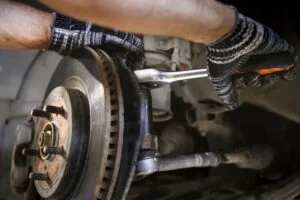Front and Rear Brake Pad Replacement
Introduction
Brake pads are vital components of your vehicle’s braking system, responsible for creating friction against the brake rotors to slow down or stop the vehicle. Over time, brake pads wear out due to constant use, requiring replacement to maintain optimal braking performance. Front and rear brake pad replacement is a critical maintenance task that ensures safe braking and prevents potential brake system failures.
Why Front and Rear Brake Pad Replacement Matters?
Brake pads undergo significant wear during braking, eventually reaching a point where they become too thin to effectively slow down the vehicle. Worn brake pads can lead to increased stopping distances, decreased braking performance, and potential damage to other brake components. Regular inspection and timely replacement of front and rear brake pads are essential to ensure safe and reliable braking.

Ensures Safe Braking Performance
Replacing worn brake pads ensures that your vehicle can brake safely and effectively in various driving conditions. Properly functioning brake pads provide the necessary friction to slow down or stop the vehicle promptly when needed.
Prevents Damage to Brake Components
Worn brake pads can cause damage to other brake components, such as brake rotors and calipers, if not replaced promptly. Timely replacement of front and rear brake pads helps prevent costly repairs and ensures the longevity of the entire braking system.

Steps Involved in Front and Rear Brake Pad Replacement
Replacing front and rear brake pads is a relatively straightforward process that can be done by most car owners with basic tools. Below are the main steps involved:
1. Gather Necessary Tools and Supplies
Before starting the brake pad replacement process, gather all the necessary tools and supplies, including new brake pads, a lug wrench, a jack and jack stands, a C-clamp or brake caliper tool, and brake grease.
2. Lift the Vehicle
Safely lift the vehicle using a jack and support it with jack stands. Ensure that the vehicle is securely positioned and that the wheels are off the ground before proceeding.

3. Remove the Wheels
Remove the wheels using a lug wrench to access the brake calipers and pads. Place the removed wheels aside in a safe location.
4. Remove the Brake Calipers
Use a socket wrench to remove the bolts securing the brake calipers to the brake caliper bracket. Once the bolts are removed, carefully slide the brake calipers off the brake rotor and suspend them using a wire hanger or bungee cord to prevent damage to the brake lines.
5. Replace the Brake Pads
Remove the old brake pads from the brake caliper bracket and install the new brake pads in their place. Apply brake grease to the back of the brake pads to prevent squealing and ensure smooth operation.
6. Reset the Brake Calipers
Before reinstalling the brake calipers, use a C-clamp or brake caliper tool to compress the caliper piston back into its housing. This step is necessary to accommodate the thicker new brake pads.
7. Reinstall the Brake Calipers
Once the new brake pads are installed and the caliper piston is reset, carefully slide the brake calipers back onto the brake rotor and secure them in place with the bolts removed earlier.
8. Reinstall the Wheels
Place the wheels back onto the wheel hub and hand-tighten the lug nuts. Lower the vehicle to the ground and torque the lug nuts to the manufacturer’s specifications using a torque wrench.
Benefits of Front and Rear Brake Pad Replacement
Replacing front and rear brake pads offers several benefits, including:
Enhanced Safety
New brake pads provide better friction and braking performance, ensuring safe and reliable braking in various driving conditions.
Improved Brake Response
Replacing worn brake pads restores the responsiveness of the braking system, allowing for smoother and more controlled braking.
Long-Term Reliability
Installing new brake pads ensures the long-term reliability of the braking system, reducing the likelihood of brake-related issues and costly repairs in the future.
Cost Savings
Timely replacement of front and rear brake pads helps prevent damage to other brake components, saving you money on potential repairs and maintenance down the line.
Conclusion
Front and rear brake pad replacement is a crucial maintenance task that ensures safe and reliable braking performance in your vehicle. By following the proper procedure and replacing worn brake pads at recommended intervals, you can maintain the safety of yourself and others on the road. If you’re unsure about performing brake pad replacement yourself, consult a qualified mechanic or automotive service professional for assistance.


